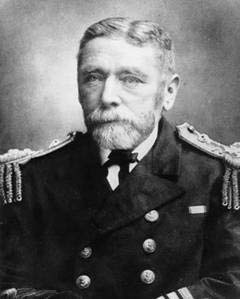Admiral John Moresby

John Moresby was born on 15 March 1830 at Allerford, Somerset, England, second surviving son of Admiral Fairfax Moresby (1786-1877) and his wife Eliza Louisa, née Williams. Educated locally, he joined the Navy at 12 as a Cadet. In 1845-49 he served as a Midshipman on the American and Mediterranean Stations and then took a gunnery course. Promoted Lieutenant in 1851, he served in South American waters and the Baltic during the Crimean War. On half-pay as a Commander from 1858, he served on the China Station in 1861-64. Promoted post Captain on 1 January 1865, he was on half-pay but worked as a marine surveyor in Ireland for five years.
In January 1871 Moresby was sent to the Australian Station in command of the 'old-fashioned paddler' HMS Basilisk. Four months out of Plymouth she put into Melbourne for repairs but was immediately ordered to Sydney and nearly wrecked in Bass Strait. After a refit Moresby was sent to New Zealand and returned to Sydney in 1872. He was then ordered to Torres Strait to suppress kidnapping from the South Sea Islands. On the way north he rescued thirteen surviving natives from the disabled Peri. Before leaving England Moresby had hoped to survey the waters off northern Australia and New Guinea and had acquired some survey instruments. From Cape York he sailed through the imperfectly charted waters of Torres Strait and sighted Saibai Island and Warrior Reefs south of the Papuan coast. He returned to Sydney and in April reported the results of his hydrographic surveys to Commodore Stirling and the Admiralty.
After a cruise to Norfolk Island and the South Seas Moresby was sent to Torres Strait. He was lent a survey officer by the Queensland Government and on his way north captured the 'black-birding' Melanie and Challenger, which he sent to Sydney and had their masters successfully prosecuted in the Vice Admiralty Court under the 1872 Kidnapping Act. By 31 January 1873 he was again in Torres Strait. Hoping to land in New Guinea but uncertain of official support, he used the pretext of searching for Mikluho-Maklai. He found the deep-water channel near Jervis Island, sailed across the Gulf of Papua to Redscar Bay and further down the coast found an opening in the reef. Moresby personally conned the Basilisk into Fairfax Harbour, Port Moresby, naming both after his father. Time forced him to return to Cape York. Two months later he sailed to Yule Island, named Robert Hall Sound, then turned east and explored and charted the coast. He claimed New Guinea for Britain at Possession Island and then charted Milne Bay, where he defined the eastern extremity at East Cape.
Moresby returned to Sydney in July, and although the government and press in Sydney and Brisbane hailed his work Stirling condemned his actions and referred them to the Admiralty, which approved Moresby's work and found that he had not disobeyed orders. In January 1874 he was ordered to England and on the way sailed to Port Moresby, around East Cape to the D'Entrecasteaux Islands and up the north coast to Astrolabe Bay. This laborious and meticulous work completed, he sailed for Amboina where he found Maclay. Moresby arrived in England on 15 December 1874 and described his Australian service as 'the most notable part of my naval career'. He was applauded for his work but the Admiralty failed to recognise its quality and significance. A large part of the area charted by Moresby later became a German protectorate.
In 1876 Moresby published 'Discoveries and Surveys in New Guinea'. From 1878 he had charge of the dockyard and naval establishments in Bermuda. Promoted Rear Admiral in 1881, he became Assessor to the Board of Trade and the Court of Appeal. He retired in 1888 as Vice Admiral. In 1909 he published 'Two Admirals', an autobiography with a short account of his father's career. Moresby died at Fareham, Hampshire, on 12 July 1922. In 1859 he had married Jane Willis Scott (d.1876); they had one son and four daughters. A gifted artist, he had presented two pictures to the Australian Navy.


